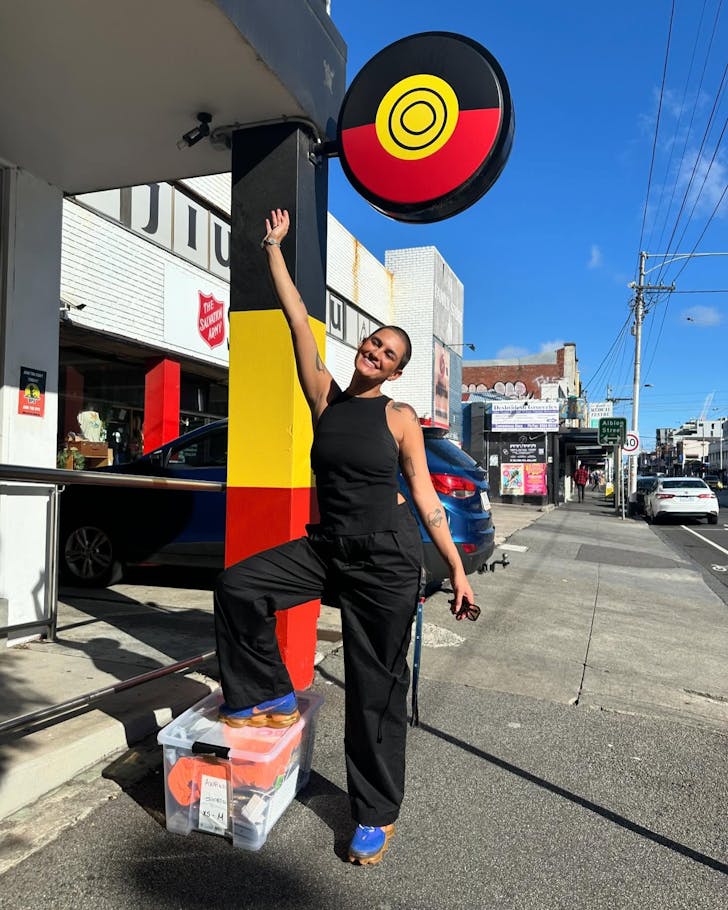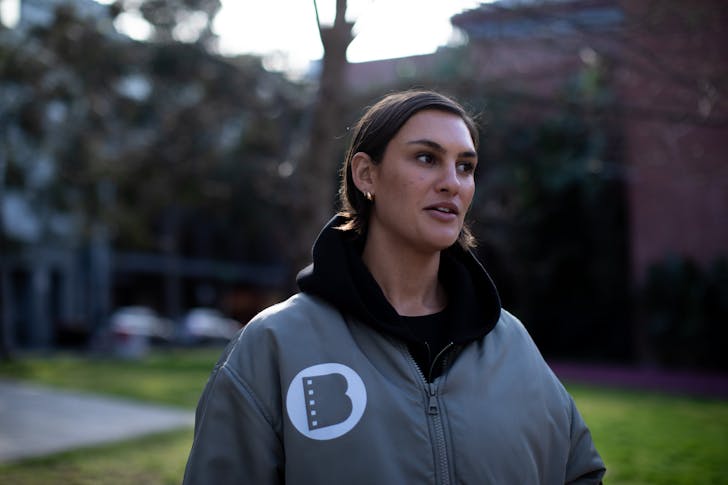Welcome to Under The Influence, our new guest editorship where we spotlight the people shaping culture across Australia and Aotearoa. Our second editor Sianna Catullo is the Naarm-based founder of Blakground Productions, a majority Aboriginal-owned and led production company. Sianna and her team shoot incredible content by Community for Community—videos with heaps of heart, care and cracking cinematography. Here, Sianna shares her personal experience launching into the creative industry and why championing representation starts behind the scenes.
I’ve worked in the creative industry for six years now. In the beginning, representation wasn’t something I thought much about—because I didn’t have to. I was working for an Aboriginal streetwear brand led by (mostly) Aboriginal women, where the talent and the audience were Aboriginal people. Representation was a given. The people in front of the camera were always reflected behind it, because it was our community telling our own stories.
In those early years, I felt safe, seen, and heard. I was given opportunities to lead, and it was the kind of environment that allowed me to learn and grow. I know I wouldn’t have my own production company today if I hadn’t first experienced that space—and if I hadn’t later seen the gaps and the need for more mob-owned and led businesses.
Over time I realised how rare that environment was. A lot of Mob don’t get to start in culturally safe spaces—they’re thrown into mainstream industries where every step forward is a fight. Knowing that makes me determined to change the industry. Because I know we can build spaces where Mob can learn and thrive—and still run successful businesses and campaigns. I’ve lived it. I’m a product of that.
You might also like:
- 11 Powerful Films Made By First Nations Directors To Watch Ahead Of NAIDOC Week
- 38 Of The Best Movies On Stan Right Now (September 2025)
- Meet The Designers Behind Fashion Week’s Incredible First-Ever Indigenous Runway
When Representation Feels Performative
It wasn’t until I worked with external businesses, and later freelanced on other projects, that I realised representation wasn’t “the norm.” I assumed it must be happening behind the scenes too, because it was finally starting to show up in front of the camera. For the first time, I was seeing people I could relate to in national campaigns—and I even got to be one of them.
It felt powerful to show my family and Community that our voices and stories matter.
But during the height of the Free the Flag campaign [a 2022 milestone in which the Australian Government secured the copyright of the Aboriginal Flag for free use, in line with the Australian Flag], an Australian brand asked me to speak about advocacy through fashion. I was proud to do it, but when I walked on set, no one behind the scenes could relate to me. I left feeling anxious about how my story would be told. When the campaign launched, my fears were realised. It was misinterpreted to suit the brand’s storyline. Instead of feeling proud, I felt silenced. The story wasn’t mine anymore—it was the version of me the non-Indigenous people behind the scenes wanted to project.
That experience taught me something important: representation isn’t just about who is visible. It’s about who holds the power to shape the story. Without Mob—or any marginalised community—in those decision-making roles, the work doesn’t feel safe, authentic, or trustworthy. It feels performative. It feels like a trend.
And yet, First Nations filmmakers and directors have been in this space for decades—pioneering, pushing boundaries, and creating internationally recognised work. Rachel Perkins, Beck Cole, Leah Purcell, Ivan Sen, Tony Briggs, Richard Frankland and others have long been telling our stories on their own terms, proving what authentic leadership in storytelling can look like.
Why It Matters
Too often, representation is treated like a box to tick. If the faces on screen are diverse, then the job is considered done. But if the people behind the scenes—directors, producers, editors, decision-makers—are all cut from the same cloth, then the story still gets filtered through the same lens no matter who is in front of the camera.
And the consequences are serious. Without cultural safety, people sharing their stories feel vulnerable. Their voices can be misused, re-framed, or stripped of context. What should be empowering becomes exploitative.
It also keeps the country uneducated. Earlier this year at Camp Sovereignty, Uncle Robbie Thorpe said something that stuck with me: if we were given the chance to tell our stories, the country would be more educated—and less racist. He’s right. We’ve all seen the racist protests across the country. That ignorance comes from a failure to let diverse communities tell their stories. As Aretha Brown once put it on a Wah Wah jumper I own: “the ones who win the war write the history.”
One of the most powerful ways to combat racism is education. Yes, the curriculum in schools needs to change so young people grow up with more respect and understanding. But what about the adults? That’s where production comes in. Production companies have massive influence over society. Through shared passions and interests—fashion, music, business, politics—we can educate, connect, and shift culture.
That’s why I love production, and why I want to see a shift. Because production isn’t just entertainment—it shapes the fabric of national identity. Done right, it can show the rich diversity of our country. And in a digital world, production companies and social media teams hold enormous influence over what’s amplified, what’s normalised, and what’s erased.
The Barriers
So why don’t we see more diversity behind the camera, in the boardroom, or in leadership roles? It’s not a lack of creativity or talent. Mob have been here, leading and innovating, for decades. Our stories, told authentically, have the power to shift culture.
The barriers are structural. University pathways that demand years of study and a massive HECS debt. Expensive equipment that many can’t afford. Unpaid traineeships that only people with financial safety nets can take on. And an industry culture where who you know often matters more than what you bring. Meanwhile, those who rise fastest are often the same type of person: middle-class, usually white, able to work for free, able to build a portfolio on opportunities not accessible to others. Privilege gets recycled into opportunity. And the cycle continues.
I see the same thing in social media. Mob are on socials—we live and breathe it like everyone else. Yet I’m constantly disappointed when businesses and organisations with a First Nations focus hire non-Indigenous people into their comms roles. And I’ve seen the impact: deficit language, stereotypes, cringe lingo, and stories filtered through the white gaze. If Mob aren’t the ones shaping the narrative, it doesn’t matter how many First Nations faces you put in the posts—the story is still missing the mark
Production and comms teams are powerful educators in a digital world. The way they tell stories can challenge racism, shift perceptions, and build respect. Or, if done without us, they can reinforce ignorance and keep the country uneducated.
You might also like:
- 13 Indigenous-Owned Businesses You Need To Shop Right Now
- Reconciliation Week Is More Than A Morning Tea, Here’s How To Really Act On It
- Tune In To These 13 Epic Indigenous Podcasts In 2025

What Change Looks Like
Change doesn’t mean non-Indigenous businesses can’t tell diverse stories. The reality is First Nations people make up just 3% of the population—we know we need non-Indigenous people working in our spaces. But it does mean they have to operate differently when they do.
I’ve seen this work well. Recently, a non-Indigenous company brought me on as a producer and cultural consultant for a project on First Nations running, and hired another First Nations cinematographer alongside their own. They recognised their skills and experience, but they also valued ours—and they let us lead where it mattered. That’s what cultural safety looks like: respect, trust, and collaboration.
I’m grateful for the opportunities I was given, and I want to do the same for others. That’s why I started Blakground. Whether it’s through our pathway program creating entry points for First Nations creatives, or by bringing in local Mob from the Country and Communities we’re filming on, the focus is always the same: building spaces where First Nations people feel seen, heard, and safe.
It’s not complicated: put more Mob—and more people from underrepresented groups—in leadership positions, not just as assistants or token hires. Build structures that make space for people who don’t fit the “stereotypical” mould.
And if you don’t have the representation needed for a particular story? Maybe you’re not the right person to tell it.
A Challenge To Every Industry
Representation behind the scenes isn’t just a creative problem—it cuts across every sector. Australia needs a cultural shift. The fabric of our national identity is diversity, and that’s something everyone benefits from.
When storytelling is authentic, everyone wins. We all get richer, more complex, more human stories. Brands and businesses earn deeper trust and stronger connections. Audiences get work that resonates, not just content that ticks a box. And as a country, we get closer to truth telling and to building a more inclusive future.
So ask yourself: who is shaping the stories in your workplace? Who’s making the decisions? Are you creating space for authentic storytelling and representation? Because if the answer doesn’t reflect the people you’re trying to represent, then the work isn’t authentic. It isn’t safe. And it isn’t yours to do.
Representation doesn’t stop when the cameras do. It starts behind the scenes, in the places no one else sees. And if we can’t get that right, then all the diversity we put out front will always be just that—a front.
Now grab some popcorn and settle in for 11 First Nations movies and shows you need to stream on Netflix in 2025.





